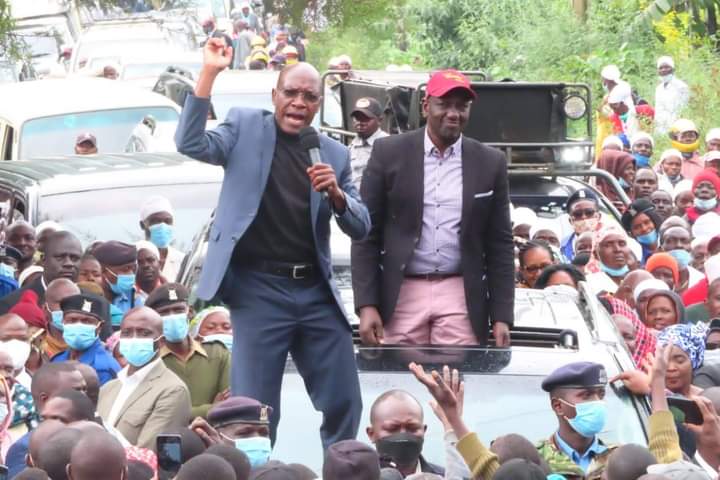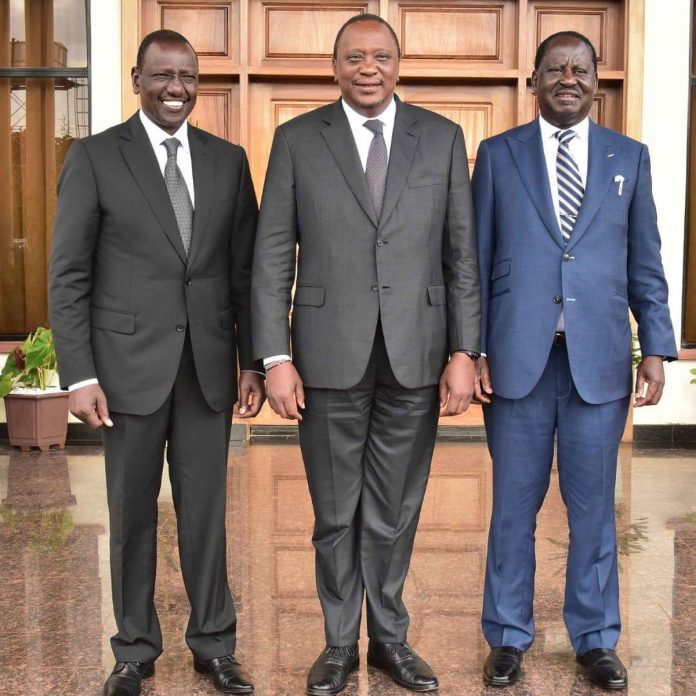Nairobi
By Kwendo Opanga
The frenzied politics building up to the August General Election was ushered in by the detente (handshake) between President Kenyatta and Mr Raila Odinga in March of 2018.
Some background is in order. Odinga pushed Kenyatta and Kenya against the wall and to the brink respectively, by leading political and economic sabotage (resistance) of the administration from October of 2017.
Odinga branded the newly sworn in government illegitimate and malevolent, then swore himself in as president in January of 2018 and called for the secession of western Kenya.

Raila Odinga during his mock swearing on as the Peoples President at Uhuru Park This after rejecting the results of the August 2017 presidential poll and challenging them in court, then boycotting the court-ordered repeat poll of October. He said it would be rigged anyway. Cornered, the President entered talks with Odinga.
But that is not the way the President explains it. Since his Sagana III meeting with Kikuyu leaders in February, Kenyatta has repeatedly said he turned to Odinga for help because his house was on fire, but Deputy President William Ruto was not going to his rescue.
And, the President says, Ruto took a hardline position against Odinga, arguing that the government was legally constituted and the President was legitimately in power. He should therefore charge Odinga with treason. So they fell out.
If this is the case, then, the first and second in command fell out on a matter of principle; Ruto batting for the legitimacy of government and the President for the indivisibility of the country.
Therefore Kenyatta avoided the nuclear option of taking Odinga to court, and, instead, brought him into the tent to the chagrin of Ruto. Thereafter, the President concedes, he has increasingly turned to Odinga for advice and deferred to him on important matters of state to the exclusion of Ruto.
The President has not been this categorical when trying to tie Ruto to corruption and or misuse of public resources. But in Sagana he obliquely referenced the non existent hydro power dams of the Rift Valley for which public money was disbursed.
Still, per the President, Ruto’s original sin is that instead of dedicating his time to working for the people of Kenya he embarked on early campaigns for the presidency.

Deputy President William Ruto (right) and former kakamega senator Bonny Khalwale during a campagin RallyBe that as it may, handshake politics, originally billed as the harbinger of peace, has mutated into a full-fledged putsch by Kenyatta and Odinga for their takeover of State House, Parliament, Council of Governors and County Assemblies in August.
However, charity begins at home, which is why since last year, Kenya’s media have been promising their publics a campaign blitz by the President against Ruto.
The krieg, they have reported, will start in Kenyatta’s vote-rich Mount Kenya backyard before going to the rest of the country.
It is a conundrum that Rutoism (dynastic politics and bottom-up economics) and Ruto, would be respectively entrenched and ensconced in Mount Kenya, so much so that the President would mount an offensive to evict them.
What has been clear since the start of the year is that the August polls will pit the Kenyatta and Odinga -fronted Azimio La Umoja (Declaration of Unity) coalition against the rival Ruto-led Kenya Kwanza (Kenya First) Alliance.

Deputy president william Ruto left, president Uhuru Kenyatta centre and former premier Raila Odinga Left in a past functionThat means for the first time in Kenya’s post-independence electoral history competing poll formations have coalesced around an outgoing President and the second in command who seeks to succeed him.
Whether Kenyans regard it as the government being torn down the middle, a case of the enemy being within or the government cannibalising itself, it has made for gripping electioneering long before the poll is officially called.
This is also the first time that the President has teamed up with a politician who has fought him and his deputy fiercely in three presidential polls, to take on the same deputy in a contest for power.
And, for the first time Kenyans have seen the President and his deputy, who were previously high-fiving, dress-alike buddies, go hammer and tongs at each other like pound-for-pound boxers, in a four-year-long slugfest.
But, from the outset the playing field is tilted. The Azimio presidential corner features Odinga and his running mate – plus the President. The Kenya Kwanza ticket features Ruto and his running mate. That’s three against two.
The President has a dog in the fight and is himself in the fight. When the President is, or has, a dog in the fight, then, the issue of the fight in the dog is a foregone conclusion.
But, did not the crowded Kenyatta, Mudavadi and Moi ticket lose in 2002? It did despite Moi being and having a dog in the fight.
But, as demonstrated in the last instalment, the organisation, longevity and ferocity of Kenyatta’s onslaught for Odinga against Ruto, puts Moi’s fight for Kenyatta against Kibaki to shame.
Second, Moi had been president for 24 years and the idea of his reincarnation in Kenyatta was hugely off-putting for many Kenyans.
The President has left nothing to chance since 2018 when he shook hands with Odinga to put a public seal to a privately concluded deal. He has made his handshake partner an unelected powerhouse and together they have rendered Ruto a deputy in name only.
Ends




